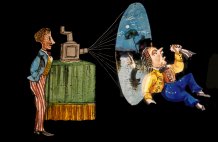
The show is part of the British Association for Victorian Studies 2018 Annual Conference
See the magic of Victorian “magic” lanterns come alive at Exeter show
Beautiful Victorian images can be seen in spectacular style using a rare magic lantern at a special one-off show in Exeter.
Magic lanterns were a popular form of entertainment for more than 300 years before the invention of the TV and radio. They were a form of slide projector where people could show their own photographs or paintings in private homes or at public events in churches, town halls and schools to delight and enlighten audiences.
A new free show at the University of Exeter will allow people to see original glass slides shown through an authentic triple magic lantern, which has three projectors. This complex device allows images to be shown at a fast pace, allowing projectionists to create the most spectacular effects the lantern can produce.
The show is part of the British Association for Victorian Studies 2018 Annual Conference, held at the University of Exeter this week. Academics from the University are digitising thousands of irreplaceable magic lantern slides for future generations to see. The slides, hand-painted images or photographic transparencies, are held in museums around the country but are too fragile to be on display. Digitising them preserves the images, and also allows them to be used again in exhibitions and as a historical resource.
Professor Joe Kember, from the University of Exeter, who is leading the research project, said: “We are looking forward to this show. The lanternists Carolyn and Jeremy Brooker have been performing together for over 20 years and are masters of using the equipment, which is complex and demanding. This should be a unique experience for all ages.”
Dr Jeremy Brooker has been giving magic lantern shows since he was fourteen years old. He is also a professional musician who has collaborated with a wide range of artists and other performers, as well as creating original slide images of his own. He has written extensively about the magic lantern.
Early magic lanterns used candles and oil lamps as the light source, and later became powered by elaborate gas-fired ‘limelight’ burners, and then by electricity. Some lantern slides had mechanical devices to give the illusion of movement to the otherwise static images. The lantern’s heyday was around the end of the 19th century, when a worldwide network of businesses made, sold and hired slides. In the middle of the 20th century it gradually evolved into the common ‘slide projectors’ seen in many homes and institutions and then the digital ‘data projector’ found everywhere today.
The show, “A Grand Gothic Magic Lantern Entertainment”, will be held on Thursday, August 30 from 18:30 to 19:30 at the Roborough Studios on the University of Exeter’s main campus. Register here: https://www.eventbrite.co.uk/e/a-grand-gothic-magic-lantern-entertainment-tickets-49241352210
Date: 24 August 2018
